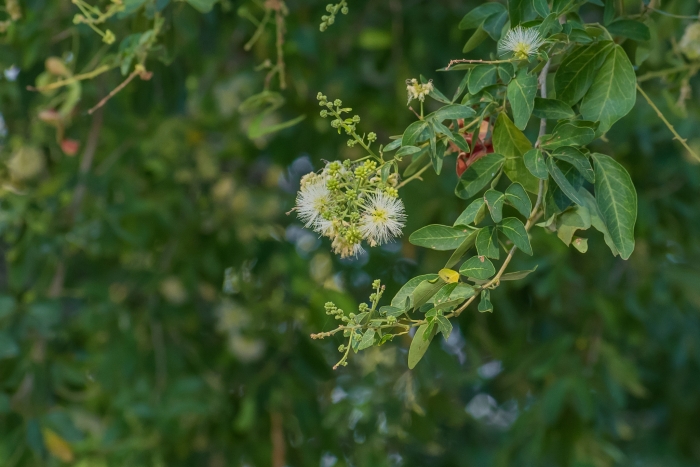Manila Tamarind
(Pithecellobium dulce)
Manila Tamarind (Pithecellobium dulce)
/
/

© Guillermo SG
CC BY 4.0
Image By:
© Guillermo SG
Recorded By:
Copyright:
CC BY 4.0
Copyright Notice:
Photo by: © Guillermo SG | License Type: CC BY 4.0 | License URL: http://creativecommons.org/licenses/by/4.0/ | Uploader: guillermo_sg | Publisher: iNaturalist |

























Estimated Native Range
Summary
Pithecellobium dulce, commonly known as Manila tamarind or Madras thorn, is a deciduous tree native to tropical dry forests on the Pacific Coast of Mexico, extending to Central America and northern South America. It typically grows to a height of 33-49 feet (10-15 meters) and has a distinctive spiny trunk and bipinnate leaves. The tree is notable for its greenish-white flowers that bloom in clusters, followed by curved, pink or white seed pods. These pods contain a sweet and sour pulp that is edible and often used in traditional dishes. The flowering season is not strictly defined, as it can vary depending on the climate, but generally occurs during the warm months.
Manila tamarind is valued for its fast growth, tolerance to drought, and the edible pods it produces. It is often used in tropical and subtropical regions for shade, ornamental purposes, and as a living fence due to its spiny nature. In cultivation, it requires full sun to part shade, well-drained soils, and can tolerate a range of soil types. While it is drought-tolerant once established, young trees benefit from regular watering. It is important to be cautious when planting Manila tamarind outside its native range, as it can become invasive, particularly in places like Hawaii. Its potential invasiveness is due to its ability to produce numerous seeds that are easily dispersed by animals and its capacity to grow in a variety of environments.CC BY-SA 4.0
Manila tamarind is valued for its fast growth, tolerance to drought, and the edible pods it produces. It is often used in tropical and subtropical regions for shade, ornamental purposes, and as a living fence due to its spiny nature. In cultivation, it requires full sun to part shade, well-drained soils, and can tolerate a range of soil types. While it is drought-tolerant once established, young trees benefit from regular watering. It is important to be cautious when planting Manila tamarind outside its native range, as it can become invasive, particularly in places like Hawaii. Its potential invasiveness is due to its ability to produce numerous seeds that are easily dispersed by animals and its capacity to grow in a variety of environments.CC BY-SA 4.0
Plant Description
- Plant Type: Shrub, Tree
- Height: 15-50 feet
- Width: 15-50 feet
- Growth Rate: Moderate, Rapid
- Flower Color: N/A
- Flowering Season: Spring, Winter
- Leaf Retention: Deciduous
Growth Requirements
- Sun: Full Sun
- Water: Low, Medium
- Drainage: Medium, Fast
Common Uses
Bird Garden, Border Plant, Edible*Disclaimer: Easyscape's listed plant edibility is for informational use. Always verify the safety and proper identification of any plant before consumption.
Natural Habitat
Tropical dry forests
Other Names
Common Names: Manila Tamarind, Sweet Inga, Monkeypod, Blackbead, Camachile, Guayamochil, Opiuma
Scientific Names: , Pithecellobium dulce, Acacia obliquifolia, Albizia dulcis, Feuilleea bertolonii, Feuilleea dulcis, Inga camatchili, Inga dulcis, Inga javana, Inga javanica
GBIF Accepted Name: